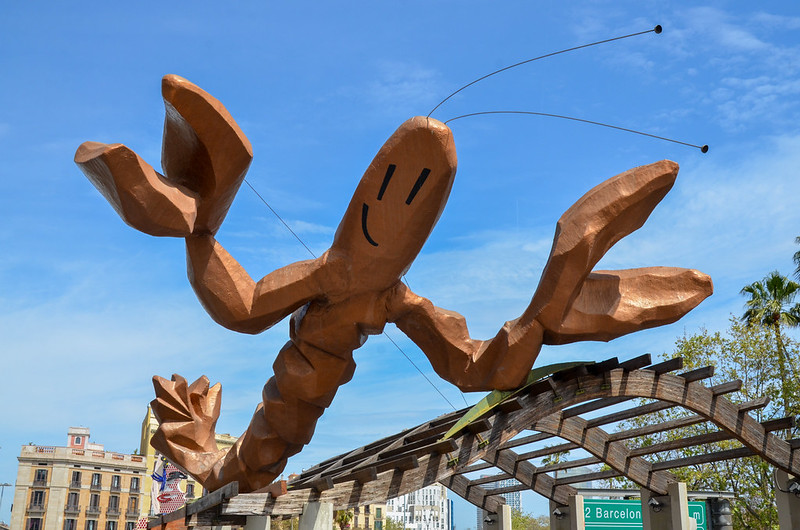The beautiful Gothic, Roman and Art Nouveau influences of Barcelona are very well known. The city’s public art culture is, unsurprisingly, one of the best in the world. The city is eclectic and has a remarkable history in both art and architecture. Here, we’ve listed the top public artworks. They combine meaningful modern and contemporary architecture with the historic streets of the city to create an intoxicating blend.
TABLE OF CONTENTS
Peix
First on the list, this sculpture by Canadian architect Frank Gehry is the biggest. It is an astounding 56 metres in length and 35 metres in height. Gehry made the Fish for the 1992 Olympic Games, just like many other modern public sculptures in Barcelona. The sculpture exemplifies Gehry’s audacious, sculptural aesthetic.
The golden mesh surface of the Fish is made up of interwoven stainless steel stripe patterns. These ‘scales’ serve as fantastic reflectors for the sun, which produces dancing reflections that resemble those that gleam off the ocean next to it.
The Face of Barcelona
Roy Lichtenstein created a massive Pop Art face especially for this city, built in his recognisable comic book-like style. The Face of Barcelona most obviously represents the enormous transformations the city underwent in preparation for the 1922 Olympics. This provocative female grimace, which stands 15 metres tall and is covered in brightly coloured tiles, attracts the inevitable attention of onlookers and has grown to be one of the most popular sculptures with tourists.
The Cubes
Due to its peculiar name, The Wounded Shooting Star, also know as The Cubes, has long been a perplexing piece of art. Just before the Olympics, German artist Rebecca Horn placed it on the La Barceloneta beach. Many people believe that it is a tribute to the chiringuitos, the local beech bars that were formerly quite popular but were destroyed on the eve of the Olympics. The ‘old stars’ in architecture had to make way for the new ones during the 1992 global architectural modernization. Another common myth claims that the sculpture is modelled after the little apartments seen in La Barceloneta’s historic homes. If you live there, you’ll undoubtedly agree that this version has strong foundations as well.
The Fat Cat & The Fat Horse
One of the most adored works of art in the city, the fattest cat of Barcelona, resides on the Rambla del Raval. Fernando Botero, a Colombian artist, produced it in 1987. Initially put in place at Ciutadella Park close to the zoo, it was transferred to the Olympic Stadium region in 1992, then to a small square of Blanquerna close to the Drassanes metro stop. It moved to Raval back in 2003 where it now resides, and it is still one of the most well-known installations in the city.
The Fat Horse, another work by Botero, is on display in the airport’s terminal at El Prat. Botero’s artwork makes reference to the infamous Trojan Horse and connects to the idea of people wandering the globe.
The Woman and the Bird
The Woman and the Bird is a provocative work, as are all of Joan Miró’s creations. The statue is a duet between life and death that symbolises the fusion of the masculine and feminine. It is pronounced Dona i Ocell in Catalan; ocell, in addition to meaning “bird,” also has a slang equivalent of “penis” in Catalan. Indeed, the work’s upper section inspires these comparisons. You can clearly see an abstract female figure in the vertical corpus. Just before the renowned artist passed away in 1983, the statue was erected in the Joan Miró Park.
La Gamba
One of Barcelona’s funniest symbols is La Gamba by Javier Mariscal, which is located on the Moll de la Fusta quay between the Columbus Column and the Central Post Office building. It was once a decorative feature of the 1989-opened seafood restaurant Gambrinus. The establishment gained a lot of local popularity as a result of its unique façade (which resembled a transatlantic ship), created by architect Alfred Arribas, and this enormous sea creature on the roof. After the Olympics, though, it became insolvent and was quickly torn down. The city’s storehouse has housed the statue of the prawn for ten years. It wasn’t until 2004 that the city decided to reinstate it in order to amuse onlookers and provide them with a shaded place to rest during the sweltering summer afternoons.
Barcelona is in some ways an open-air museum where you can see an array of sculptures from the 20th century’s end made by renowned artists. Enjoy these works of art alongside our Gaudí Segway Tour to see some architectural masterworks.











